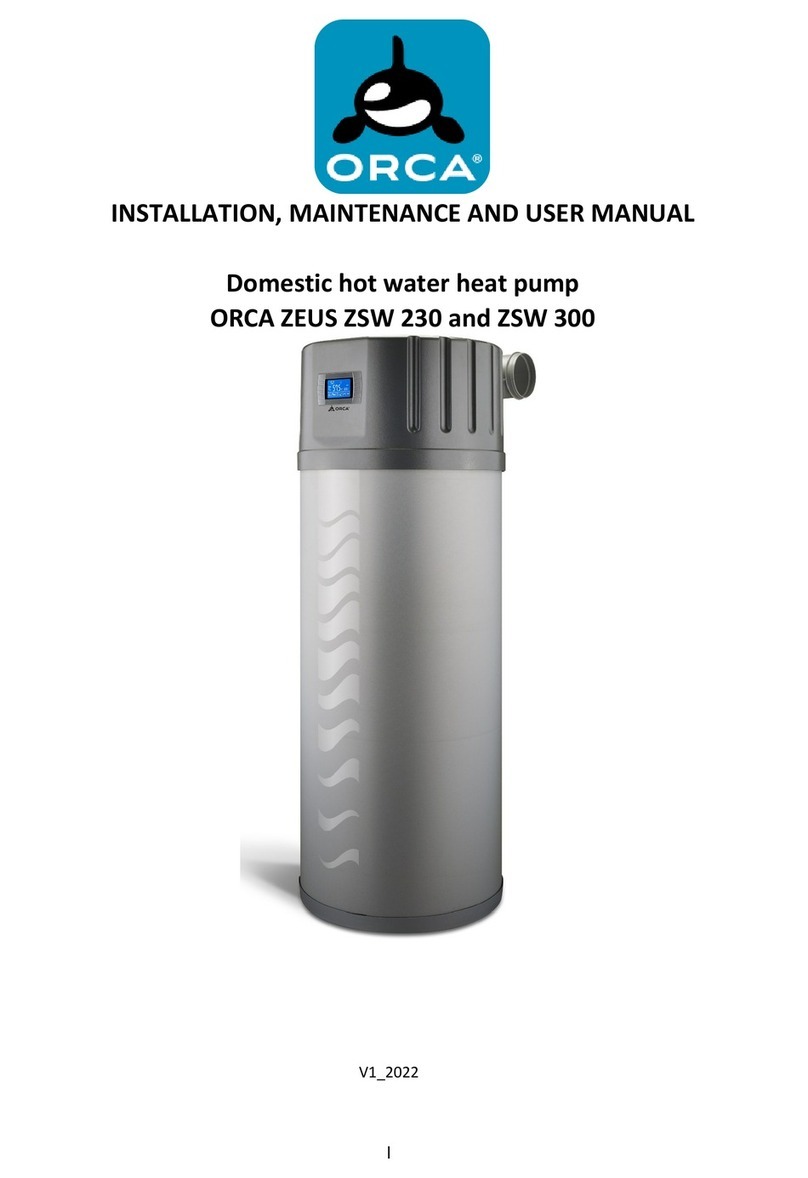1
1Important warnings
-This unit must be well earthed during operation; otherwise serious injuries and also death can occur.
-Power supply must be protected with a safety FI switch (current to switch off max. 0,03A).
-Newer incline the unit for more than 30°from its vertical position.
-Do not install the unit in space with a lot of dust or chemical gasses in the air, the unit can be damaged.
-Do not install the unit in a space where the temperature can fall below 0°C, water in the pipes and unit
can freeze and cause damage to the unit or pipes.
-One way valve and cleaning filter must be installed on the cold water inlet pipe
-On the hot water outlet pipe, installation of a pressure safety valve (max. 0,7MPa) is MANDATORY. The
maximum allowed pressure in the heat pump is 0,3MPa.
-Do not insert fingers of other objects into holes for air inlet and outlet. Rotational parts in the unit can
harm you.
-The unit needs to be installed in a dry space, if it is exposed to direct sun it needs to be protected for it.
-Ensure a clean working environment of the heat pump. Periodically check and, if needed, clean the
working environment of the heat pump. This way, the frequencyof evaporator cleaning will be decreased
and proper and optimum operation of the heat pump will be ensured.
-If the intended installation location of the heat pump is in a room or area, where there is a lot of dust or
ash, possibility of volatile and explosive substances or other undesirable substances leakage, wood or
pellet stove, it is necessary the air intake for the heat pump is made from a different room. Dust and ash
can accumulate on the evaporator and in the interior of the heat pump, which can lead to malfunction
or failure of the heat pump. Leakage of volatile and explosive substances can cause an explosion or fire.
-Do not use or store flammable materials near the unit
-The unit must be connected to power supply protected with the prescribed fuse.
-Only an adult person acquainted with the content of this manual, can operate the heat pump.
-In case of power supply cable damage, smoke, unusual smell from unit or any other abnormality in
operation, immediately disconnect the power supply cable from the supply and contact an authorized
service person.
-The unit can only be used for purposes prescribed by the manufacturer.
-The unit must be replaced and disposed according to local regulations; it contains environment
potentially harmful gasses.
-Water with temperature above 50°C can cause injuries, when set temperature is higher than 50°C be
more careful when children and other users are using hot water.
-During operation it is forbidden to move, clean or repair the unit.
-Do not put any object below or on the unit.
-Unit Installation must be performed by a qualified installer and always in non-electrically supplied
condition.
-There needs to be enough space left around the unit, in case of cleaning and maintenance.
-When connecting the heat pump to the system, it is not recommended to use galvanized transition pieces
or copper pipes in order to prevent corrosion by a galvanic couple. It is advisable to use short flexible
tubes to connect the heat pump to the system. Detailed information about possible faults, their removal
and protection are described in standards SIST EN 12502-1 and SIST EN 806-4.
2Purpose of device
The device is an air-water heat pump that can be connected to a water storage tank with an integrated heat
exchanger. Its primary task is to heat sanitary water –the cooling effect on the surroundings of the device is





























